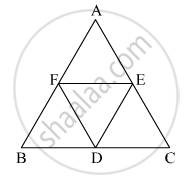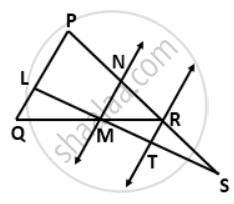Advertisements
Advertisements
प्रश्न
In the given figure, ΔABC is an equilateral traingle. Points F, D and E are midpoints of side AB, side BC, side AC respectively. Show that ΔFED is an equilateral traingle.

उत्तर
Given: ∆ABC is an equilateral triangle and D, E and F are mid-points of BC, AC and AB respectively.
To prove: ∆FED is an equilateral triangle.
Proof:
In ΔABC,
Points F and E are the midpoints of sides AB and AC respectively. ...(Given)
∴ FE = `1/2` BC ...(From midpoint theorem) ...(i)
In ΔABC,
Points D and E are the midpoints of sides BC and AC respectively. ...(Given)
∴ DE = `1/2` AB ...(From midpoint theorem) ...(ii)
In ΔABC,
Points D and F are the midpoints of sides BC and AB respectively. ...(Given)
∴ DF = `1/2` AC ...(From midpoint theorem) ...(iii)
Now, ΔABC is an equilateral triangle.
∴ BC = AB = AC ...(Sides of equilateral triangle)
∴ `1/2` BC = `1/2` AB = `1/2` AC ...(Multiplying both sides by `1 /2`)
∴ FE = DE = DF ...[From (i), (ii) and (iii)]
∴ ΔFED is an equilateral triangle.
APPEARS IN
संबंधित प्रश्न
In Fig. below, BE ⊥ AC. AD is any line from A to BC intersecting BE in H. P, Q and R are
respectively the mid-points of AH, AB and BC. Prove that ∠PQR = 90°.

ABCD is a parallelogram, E and F are the mid-points of AB and CD respectively. GH is any line intersecting AD, EF and BC at G, P and H respectively. Prove that GP = PH
In triangle ABC, angle B is obtuse. D and E are mid-points of sides AB and BC respectively and F is a point on side AC such that EF is parallel to AB. Show that BEFD is a parallelogram.
In triangle ABC, D and E are points on side AB such that AD = DE = EB. Through D and E, lines are drawn parallel to BC which meet side AC at points F and G respectively. Through F and G, lines are drawn parallel to AB which meets side BC at points M and N respectively. Prove that: BM = MN = NC.
In ΔABC, BE and CF are medians. P is a point on BE produced such that BE = EP and Q is a point on CF produced such that CF = FQ. Prove that: QAP is a straight line.
In ΔABC, P is the mid-point of BC. A line through P and parallel to CA meets AB at point Q, and a line through Q and parallel to BC meets median AP at point R. Prove that: AP = 2AR
In ΔABC, D, E and F are the midpoints of AB, BC and AC.
Show that AE and DF bisect each other.
The diagonals AC and BD of a quadrilateral ABCD intersect at right angles. Prove that the quadrilateral formed by joining the midpoints of quadrilateral ABCD is a rectangle.
In the given figure, PS = 3RS. M is the midpoint of QR. If TR || MN || QP, then prove that:
RT = `(1)/(3)"PQ"`
The quadrilateral formed by joining the mid-points of the sides of a quadrilateral PQRS, taken in order, is a rhombus, if ______.
